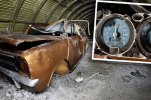Eric Gibson
master brummie
I think that's a job in progress, the wood is 'shuttering' used to make a mould for the concrete, the bars above are 'rebars' reinforcement and would be concreted in when it's finished.
I think that must be it. I would think even the tree in the background is not 400 ft above the Lord Mayor.wonder if that is just the front of the shelter it does say 400 ft.the rest might have been coverd in soil. dont think we will ever know Viv.
 www.28dayslater.co.uk
www.28dayslater.co.uk

 www.derelictplaces.co.uk
www.derelictplaces.co.uk
Post in thread 'The Austin's aero industry in the 1940's'Yes there was. I’ve seen photos of a Royal Visit to the shadow factory. They were making ‘fairy’ something or others. Must try and find the details. Viv.
That must have been where I saw it Pedro. Thanks. I see it’s Fairey not Fairy ! And that factory was at Colton Hackett. Should it be Coften ? Viv.Post in thread 'The Austin's aero industry in the 1940's'
https://birminghamhistory.co.uk/for...-aero-industry-in-the-1940s.42123/post-751469
they found a old mini dumped down there with a few miles on the clock
Report - - Longbridge Underground Tunnels - East Works - February 2012 | Underground Sites
Longbridge Underground Tunnels - East Works About time I shared these……………probably the most interesting site I’ve ever visited to document. Again, credit to all those who have managed to gain access to any of the networks underneath Longbridge prior to this visit. Don’t know...www.28dayslater.co.uk

Maps below show where the entrance was on maps for the 1880s and 1938Birmingham Post, August 1939. West Bromwich.
View attachment 167576
View attachment 167577View attachment 167578View attachment 167579


I lived in Erdington through the war. I was the youngest child and had two sisters. We didn’t really understand what was happening but Fort Dunlop, Aston Chain and hook, and Rollisons Wire factories were close by so it seems we were bombed quite regularly. After tea all three of us were put to bed in the Anderson shelter because Mum said that she couldn’t carry all three of us out to the shelter when the air-raid warning sounded. The shelter didn’t have a door but the dustbin was pulled against the opening. We had two women war workers staying with us but they always stayed in bed during raids .They said that if they were going to die they would prefer to be in bed! Eventually my two sisters were evacuated but I was kept at home but one of the war-workers, Chris, arrange for all three of us to stay with her family for a time in Scotland on a farm. We went to the local school and were very happy there and well away from the bombing.Between Grasmere Road and Ashwin Road in Handsworth there is a pedestrian tunnel through the railway embankment. I believe it runs parallel to (and possibly above) Hockley Brook.
I have a memory of one night only in 1940 when I was visiting my Nan at 62 Grasmere Road, being bundled overnight with all the locals in the tunnel, which had had about eight brick "blast walls" built in. These blast walls came in pairs, about five feet apart, across all but five feet of the width, so that you (and perhaps the blast of a bomb) had a slalom to get through.
At home we had an Anderson shelter in the garden, but that tunnel was a very social place, and to a seven-year-old it was quite an experience.
During the day it was fun too, because there was next to no lighting between these barriers, and you (well, I did) needed confidence to charge through these unfathomable chambers.
It was also a challenge to the ear. Kids always loved to shout and stamp their feet going through the tunnel before the blast walls were put in, and afterwards as well. But when the walls were there and I was just a titch, the sounds could be terrifying.
Peter
Hi. I used to live on Harman Road (1978-1990) and this shelter was one of my favorite places to go in my childhood. Thanks for the memory trip.right folks i think these are the best of the lot...the shelter which is in the car park behind the co op wylde green is very long and covered in ivy now..please excuse the fingers showing in the shots taken of the inside as it was very difficult getting the camera in the gap at the right angle..looks to be modern rubbish in there but unless the roof comes off who knows what ww2 relics could be hidden..note the corrugated sides inside the shelter..fascinating it of history..if anyone wants to post these photos on any other internet site as always i have no objection at all but i would ask that you credit the birmingham history forum...thanks
lyn
pic 1 the length of the shelter overgrown roof with ivy
pics 2.3 and 4 entrance bricked up
pic 5 is the end of the shelter with some concrete broken off this is where the camera went in
pics 6.7 and 8 the inside of the shelter
.View attachment 155329View attachment 155330View attachment 155331View attachment 155332View attachment 155333View attachment 155334View attachment 155335View attachment 155336
when i worked for the council in late 60 70s i had the job of going around to allotnents and gardens. removing them becouse the were rusty and dangerously sharpI spotted this on Face Book the other day. It is located in a back garden in Kings Heath
 www.homesweethomefront.co.uk
www.homesweethomefront.co.uk
When we moved to Short Heath in 1959, there was an Anderson Shelter shed in the garden. I recon they must have used the corrugated iron from two or three shelters to build it.When the war ended those curved panels made excellent sleds.
There were some people who thought they were safer in the house. My grandfather was one. They had a bomb hit their back garden in Hermitage Road and blow the next-door neighbour garden shed to bits. There were bits of the shed all over the roofs of the terraced houses and it left a significant crater in the garden. The soil was four feet high up the back door.I’ve given this some thought about the panels we had in our garden. I have a feeling they were never assembled. They didn’t look like they’d been dug/sunken into the ground and I certainly don’t remember one assembled. They weren’t shiny just very rusted. They’d been stacked together against the coal shed and it was only when they were moved that I took any notice. My dad bought the house after the War so the previous owners must have taken delivery of them and not assembled the parts. So where did they go for protection ? Under the stairs? Maybe they preferred the public shelters - there were many in Kingstanding. Viv.
